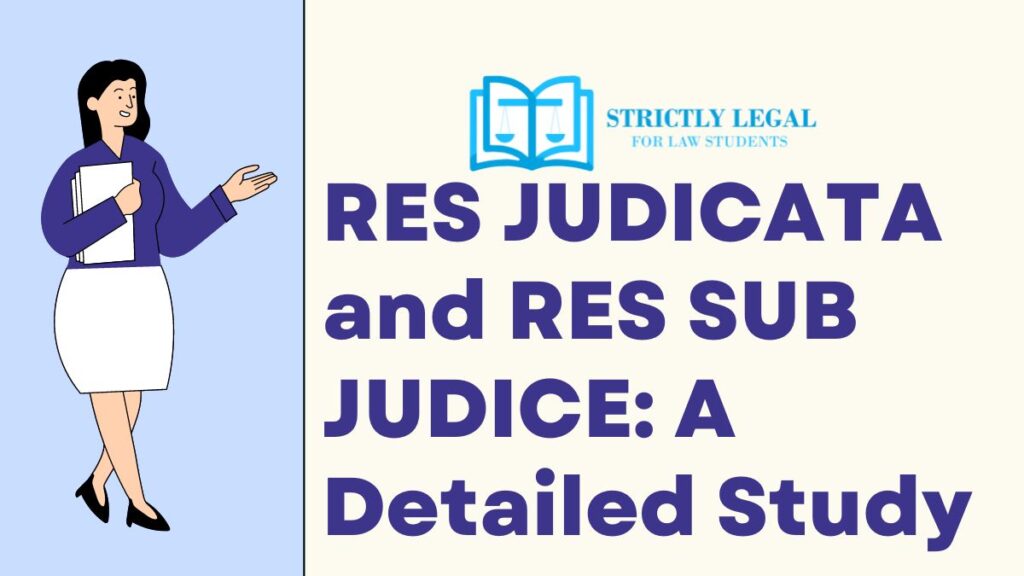The Honorable Court of Law takes reference or help from various common law and their theories to keep a balance and improve the judicial system. The main purpose of such theory is to evaluate judicial efficiency and make sure a fruitful pace of delivering justice in the Court of Law is achieved. The Doctrine of Res Judicata and Res Sub Judice are two of those principles that help the court of law and are further described in this article.
Res Judicata is a Latin term that portrays, “a matter that has been judged”. The theory or doctrine of Res Judicata prevails from continuing litigation on the same matter among the same petitioner and respondents when the matter has already been decided and a judgment has already been passed in the Court of Law so that the matter is no longer prone to appeal. This doctrine has been discussed in detail u/s 11 of the Civil Procedure Code, 1882.
Res Sub Judice is also derived from a Latin maxim, which portrays “under judgment”. The Doctrine of Res Sub Judice is established on a public policy that refrains the petitioner or plaintiff from filing two parallel allegations on the same subject matter, freezing the probabilities of two courts passing contradicting rulings. This doctrine exists to prevent replication of processes and to prevent antithetical rulings. This doctrine has been discussed in detail u/s 10 of the Civil Procedure Code, 1882.
Concept of Res Judicata
Res Judicata simply means an issue that has already been taken up by any court cannot be brought up again, may it be the same court or any different court under the ambit of Res Judicata. This happens because the Doctrine of Res Judicata prevents or refrains any additional otherwise alleges after the judgment has already been delivered, known as the “claim preclusion”. It is a common-law practice that avoids matters from being re-litigated in the Court of Law between the same parties.
The goal of Res Judicata is to prevail:
- Injustice to the parties in dispute that was to be solved by a decision that provided finality and obstructed any future alleges.
- Courts resources being used superfluously.
- Multiplying judgments in more than one alleges as multiple judgments/ decisions will lead to uncertainty.
- Imposing damages from the respondent more than once for the same harm caused.
Nonetheless, it should be pointed up that the aforementioned does not include the appeals procedure, which is considered the proper means to find a decision. The doctrine of res judicata will only apply to a precedent once the entire appeal and followed procedures have been worn out. In Y.B Patil v. Y.L. Patil, the Honorable Court held that once an order has been made in the ongoing proceeding, it becomes culminating and hence it becomes binding or imperative on the parties at any later stage of the same proceeding.
Concept of Re Sub Judice
The Principle or Doctrine of Re Sub Judice restricts or discourages the court to move forward with the trial of any suit in any proceedings where the concern in matter is directly or indirectly the same as a previously set in motion among the parties to the suit, and the court of law in which the matter has already been set in motion prior, has the power to accord the relief asked for. The doctrine is only applicable to the suits and NOT to the institutions. It no way bears the Honorable Court’s potentiality to proceed with interim orders such as injunctions or stays, nonetheless, it applies to revisions and claims or appeals.
The sole motto of this doctrine is to keep away the courts from loitering cases and suits which have already been decided previously. It is also a matter that the petitioner or the plaintiff shall not receive two different judgement whether in his favour or not, nor two conflicting judgement, which assures that the petitioner/ plaintiff would not be subject to undue influence. The objective is to prevail the plaintiff from getting two separate and different statutes for the same facts of the case.
The motto of Section 10 of the Civil Procedure Code, 1880 [herein after referred to as CPC], is to prevent two different courts from making conflicting and contradictory decisions for the same facts of the case. It was prosecuted in the case of Anurag and Co. And Anr. v. Additional District Judge and others, that, consolidation or combination of actions u/s 151 CPC on account of consummating the objectives of justice since it saves the party from numerous lawsuits, delays in justice, and costs for the suit. The parties also get away with having to produce the same evidence time and again.
Difference between Res Judicata and Res Sub Judice
| RES JUDICATA | RES SUB JUDICE |
| Applicable when the matter has already been decided by the court of law. | Applicable to a matter which is pending in the court of law of capable jurisdiction. |
| Prevents the trial of a suit of matter which has already been decided in any previous suit no matter if given by a court of a different jurisdiction. | Prevails the trial of a suit in which the matter is pending a decision in the previous suit. |
| Section 11 of CPC defines Res Judicata. | Section 10 of CPC defines Res Sub Judice. |
Conclusion
With the increase in the population, the number of crimes, and incompatibility among people cases coming to the Court have also risen to a great extent. As a result, these two aforementioned doctrines are followed to avoid overburdening the court of law and to deliver smooth execution of the judicial system and in time justice to the people in need. These doctrines are not portraying the denial of justice but improvising the productivity and efficiency of the Indian Judicial System. Anyway, India is the second-most populous country in the world which is already flooded with cases of all kinds, to add to its chaos, if people file two suits for the same issue, it can only be imagined by an individual how difficult and almost impossible it would be to deliver a smooth and speedy verdict to the ones in need.

Law student.
Turning legal insights into engaging narratives.




